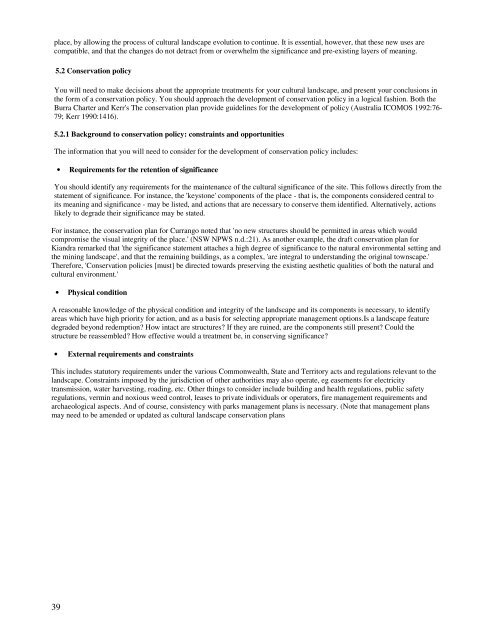Cultural Landscape Management - Australian Alps National Parks
Cultural Landscape Management - Australian Alps National Parks
Cultural Landscape Management - Australian Alps National Parks
You also want an ePaper? Increase the reach of your titles
YUMPU automatically turns print PDFs into web optimized ePapers that Google loves.
place, by allowing the process of cultural landscape evolution to continue. It is essential, however, that these new uses arecompatible, and that the changes do not detract from or overwhelm the significance and pre-existing layers of meaning.5.2 Conservation policyYou will need to make decisions about the appropriate treatments for your cultural landscape, and present your conclusions inthe form of a conservation policy. You should approach the development of conservation policy in a logical fashion. Both theBurra Charter and Kerr's The conservation plan provide guidelines for the development of policy (Australia ICOMOS 1992:7679; Kerr 1990:1416).5.2.1 Background to conservation policy: constraints and opportunitiesThe information that you will need to consider for the development of conservation policy includes:• Requirements for the retention of significanceYou should identify any requirements for the maintenance of the cultural significance of the site. This follows directly from thestatement of significance. For instance, the 'keystone' components of the place - that is, the components considered central toits meaning and significance - may be listed, and actions that are necessary to conserve them identified. Alternatively, actionslikely to degrade their significance may be stated.For instance, the conservation plan for Currango noted that 'no new structures should be permitted in areas which wouldcompromise the visual integrity of the place.' (NSW NPWS n.d.:21). As another example, the draft conservation plan forKiandra remarked that 'the significance statement attaches a high degree of significance to the natural environmental setting andthe mining landscape', and that the remaining buildings, as a complex, 'are integral to understanding the original townscape.'Therefore, 'Conservation policies [must] be directed towards preserving the existing aesthetic qualities of both the natural andcultural environment.'• Physical conditionA reasonable knowledge of the physical condition and integrity of the landscape and its components is necessary, to identifyareas which have high priority for action, and as a basis for selecting appropriate management options.Is a landscape featuredegraded beyond redemption? How intact are structures? If they are ruined, are the components still present? Could thestructure be reassembled? How effective would a treatment be, in conserving significance?• External requirements and constraintsThis includes statutory requirements under the various Commonwealth, State and Territory acts and regulations relevant to thelandscape. Constraints imposed by the jurisdiction of other authorities may also operate, eg easements for electricitytransmission, water harvesting, roading, etc. Other things to consider include building and health regulations, public safetyregulations, vermin and noxious weed control, leases to private individuals or operators, fire management requirements andarchaeological aspects. And of course, consistency with parks management plans is necessary. (Note that management plansmay need to be amended or updated as cultural landscape conservation plans39
















